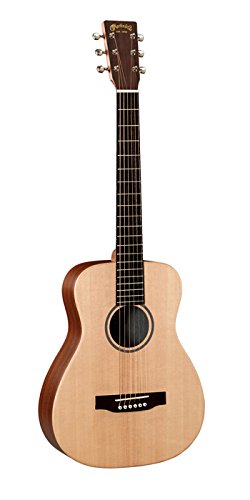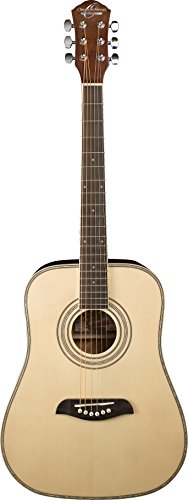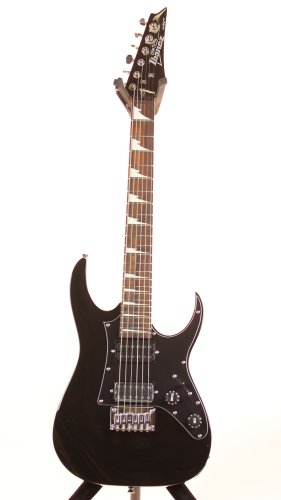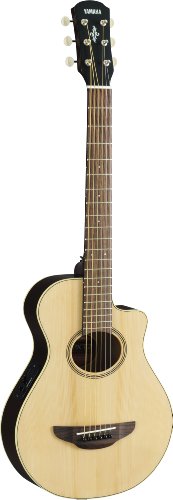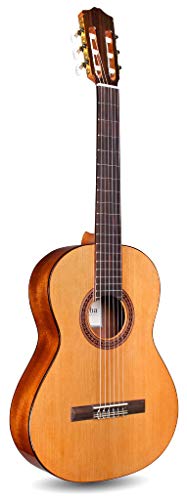Best Guitar For Small Hands: Top Picks and Reviews
Just ask ACDC front-man Angus Young: small hands are NO excuse to playing like a rock star.
All you need to do is choose the right guitar; one that’s designed for those with small hands in mind.
And we’ve spent hours researching exactly that. Keep reading for 8 great guitars for small hands (electric and acoustic options provided) and tips on how to choose. There are a few things you must keep front and center when choosing.
At A Glance:
- Best sounding: Martin LX1 Little Martin
- Best acoustic for small hands: Baby Taylor BT2
- Best electric for small hands: Fender Player Mustang 90
Buying Guide: How to Choose the Best Guitar for Small Hands
When it comes to choosing a guitar for small hands, there are several considerations to keep in mind. The shape and size of the neck, the scale length, and the guitar’s body size can all have an impact on the playability of a guitar for different hand sizes.
Mike Duffy from Fender guitars (1) emphasizes the combination of factors when he said:
The main concerns for younger players or players with smaller hands are finding a body size that is comfortable, a neck profile that allows for a proper grip and a shorter scale length, which places the frets closer together.
So as you can see, its not JUST about choosing the smallest guitar - its a combination of factors. If that sounds confusing, we’ll break down each of those factors below.
Consider the shape and size of the neck
There are six main guitar neck shapes, also known as neck profiles. Though the neck profile doesn’t impact the inherent sound of a guitar, it can have a strong influence on how you play. So your choice should take into account your preferred playing style as well as the comfort of your hands (2).
The six shapes are Oval C, Modern Flat Oval, U Shape, Hard V, Medium V, and soft V, with some variations in dimensions between brands.
The most common shape for modern guitars is the Oval C, which is comfortable for nearly everyone and is a great choice for those with small hands.
Many players find this relatively slender neck profile allows them to play faster, because the hand can move more freely.
However, the downside to the narrow neck is that it is less durable and more prone to warping.
The Medium V and Soft V shapes are considered classics, typically found on vintage guitars, but still favored by many players today, including those with smaller hands. The Soft V is also known as the compromise V because it offers enough room along the center of the neck for your thumb to play melodies over the top. The Medium V is ideal for players who are comfortable hanging their thumb over the edge of the fingerboard and who want a bit of twang in their sound.
The U Shape is also known as the baseball bat neck because of its depth and size. While these necks are popular because they feel sturdy and aren’t prone to warping, they are generally a poor choice for those with small hands and can lead to finger strains.
The Hard V and the Modern Flat Oval, also called the D shape, are the least common, typically only found on old or custom-made guitars.
A guitar neck size is defined by three dimensions, the depth, the width, and the fretboard radius. The depth is the distance from front to back; the width is the distance from side to side, usually measured around the nut; and the fretboard radius is the curvature of the fingerboard.
If you have small hands, minimizing each of these dimensions will make it easier to wrap your hands comfortably around the neck, but this will impact playability as well. For example, a tighter fretboard radius makes it more comfortable to play chords, but if you’re bending strings, a flatter radius allows for lower action.
The scale length is a big factor
The scale length of a guitar is the distance between the nut and the saddle. Even among full-size guitars, scale length can vary considerably (3). Some electrics have a scale length as low as 24”, while at the other extreme, a standard bass guitar has a scale length of 34”. Three-quarter or half-sized guitars can have even shorter scale lengths.
The scale length affects the sound of the guitar in several ways.
A shorter scale length means less tension required to get the strings to pitch, so treble notes will be warmer, fuller, and easier to bend.
But you will have less tension while strumming and will need a higher action to avoid buzzing. With a longer scale length, you can also expect full sounding bass strings.
Importantly for those with small hands, a longer scale length means the distance between the frets is increased, so a shorter scale length will be easier to play, particularly for complex chords.
Body size matters more than you think
The shape and size of the guitar’s body may not seem like an important factor when it comes to finger comfort, but ignoring it would be a mistake. If the body of a guitar is too large, you’ll end up reaching around uncomfortably to access the strings, which will put your fret hand in an awkward position.
This is particularly important with acoustic guitars, because their body size affects the projection of sound. Those built for the concert stage, like Grand Auditoriums and Dreadnoughts, can be very difficult for someone with small hands to play.
If you’re an acoustic guitar lover with small hands, look for a ¾-size Dreadnought or a smaller shape, like a Parlor or Concert. Well-placed cutouts can also make frets more accessible and simultaneously lower the weight of the guitar. An acoustic-electric is also a great option, because it relies on electronics to project sound rather than a large body.
Electric guitars are naturally slimmer than acoustics, but they can be heavy, which should be taken into account when buying for children.
Top Picks: 8 Best Guitars for People With Small Hands
If having small hands has left you feeling limited in your guitar playing, those days are behind you now. This list has a great guitar for every style of guitarist, whether you want to strum a country song, perform classical flamenco, or channel your inner rockstar
1. Martin LX1 Little Martin - Best Sounding overall
Specifications
Scale length: 23”
- Neck shape: Modified low oval
- Nut width: 1.69”
- Style: ¾-size acoustic
Founded in 1833, Martin Guitars is one of the oldest and most respected acoustic guitar manufacturers in the business, so it’s no surprise to find them atop our list.
The LX1 Little Martin is a scaled-down version of a full-size dreadnought acoustic, and though it’s the smallest guitar Martin manufactures, they’ve made no sacrifices when it comes to quality.
It’s a really durable guitar, that Little Martin. I traveled with it every single day on trains, on planes, on cars, and squished under things
Just like the larger and more expensive models, the top is solid Sitka spruce, known for its clear sound. The sides are laminated mahogany, which delivers a warm sound that blends well with the spruce, and the interior features the same high-end X-bracing seen on high-end instruments.
The body is a traditional non-cutaway design, which makes it more difficult to reach the high frets but allows for a bigger sound. The neck is a low oval shape, modified to be even more comfortable for small hands and inexperienced players.
The sound is remarkably well balanced, with the expected crisp high notes but a still audible bottom end. Indeed, the LX1 offers a much deeper and fuller sound than you would expect from a small guitar. Though initially designed for children or as a travel guitar, professional artists like Ed Sheeran have demonstrated that its unique sound has a place in concert halls as well (4).
2. Fender Player Mustang 90 - Best Electric
Specifications
Scale length: 24”
- Neck shape: C shape
- Nut width: 1.65”
- Style: Full-size electric
Fender is arguably the most famous guitar manufacturer in the world. In fact, the Fender Stratocaster is the best selling guitar of all time (5).
Which is not to say some of their lesser known models aren’t equally impressive, including the Player Mustang 90, our choice for the best electric guitar for small hands. It was first introduced in the 1960s as a low-priced option for beginners but later found popularity in the 90s grunge scene.
Related: Best Fender guitars
This is a full-size guitar, but a relatively small one. Its narrow C shaped neck and 9.5” fretboard radius make it easily playable for those with small hands. It has a short scale, which gives it a tight, compact feel, while making it easy to bend notes and pull off complex barre chords.
It produces smooth, rounded tones, with plenty of body at the low-end and mid-range. The Mustang really shines when it’s played with some grit because of its uncommon MP-90 pickups, which are known for their punchy attack.The neck pickup trends mellow and warm, while the middle and bridge positions provide a hint of twang.
3. Taylor BT2 Baby Taylor - Best Acoustic
Specifications
Scale length: 22.75”
- Neck shape: Taylor Standard Baby Profile
- Nut width: 1.69”
- Style: ¾-size acoustic
Along with Martin, Taylor is another major player in the acoustic guitar market. They are particularly well known for their mini guitars, using the same engineering and materials found in their high-end full-size guitars to produce ¾ versions that offer a surprisingly big sound.
The BT2 is the second generation Baby Taylor, a ¾-size dreadnought guitar that is our choice for the best acoustic guitar for small hands. While originally conceived as a guitar for children or travel, it has since been embraced for its unique sound and play-ability, as well as a durable construction that far exceeds its low price.
The top is tropical mahogany, which allows for strong and clear fundamentals, and the back and sides are laminated sapele. It has a soft tone profile, which makes it particularly adept at rhythm playing, but you can achieve a brighter sound by picking aggressively. As compared to a similar spruce top guitar like the Martin LX1, you can expect a darker, earthier tone from the mahogany.
4. Oscar Schmidt OG1 - Budget Pick
Specifications
Scale length: 24”
- Neck shape: not specified
- Nut width: 1.5”
- Style: ¾-size acoustic
Oscar Schmidt has been making stringed instruments since 1871, rising to prominence among rural country and blues players in the early half of the 20th century. Their long-standing expertise is apparent in their ability to craft a quality guitar at a remarkably affordable price.
The OG1 is their ¾-size dreadnought guitar, perfect for children and beginners, but with enough quality to interest the more experienced player as well. It has a select spruce top and mahogany back and sides, which provide a nicely balanced tone and expensive look.
Though mass-produced, the fine craftsmanship you would expect from a century of experience is apparent. It’s available in a number of colors, to suit the personal style of any player, each given a high-gloss finish and abalone binding and rosette. .
Its sound is surprisingly full for a small, budget-priced guitar, with clear tones, a punchy bass, and nicely balanced trebles. While it won’t match the power of a full-sized guitar or the richness of a more expensive option like the Taylor BT2, the OG1 offers considerable value for its low price.
5. Ibanez Mikro GRGM21 - Best for Kids
Specifications
Scale length: 22.2”
- Neck shape: C shape
- Nut width: 1.61”
- Style: ¾-size electric
This is the perfect guitar if you have a budding rocker at home. While children often learn on an acoustic guitar, like one of these, for kids who aspire to rock and roll, an electric guitar will provide the proper inspiration.
At three-quarters the size of a standard electric, the Ibanez Mikro is small, light, and affordable, qualities which make it a great choice for kids or any up-and-coming rock star with small hands and a tight budget. Despite its low price, its build quality remains high, and it comes in a variety of colors.
The body style tends toward a hard rock, heavy metal style of music, with a thick and punchy sound. However, it can be surprisingly versatile thanks to double humbuckers pickups and a three-way pickup selector switch, which allows for decent variation in sound and tone.
6. Ernie Ball St. Vincent - Designed for Women
Specifications
Scale length: 25.5”
- Neck shape: D shape
- Nut width: 1.63”
- Style: Full-size electric
This guitar is by far the most expensive on our list, but it’s also the coolest, with plenty of might to justify its price tag. It was designed in collaboration with Annie Clark, the singer-songwriter known professionally as St. Vincent, and optimized to fit her body and playing style (6). The result is a bold and stylish design that offers more than just aesthetic appeal.
The style is decidedly old school, reminiscent of the flying V guitars of decades past, but with modern ergonomics that favor the player. The scale is longer than most small guitars, but its slender D shaped neck and light weight make it a great option for smaller players. This is the rare guitar designed by and for women, but it has received rave reviews from male players as well.
This guitar excels at crisp attack and strong note definition, think AC/DC, rather than chunky bass or heavy twang. But the low-end power is still there when you need it. It offers a unique sound, much like St. Vincent herself, with impressive intonation and a vibrant, ringing sustain.
7. Yamaha APXT2EW - Best Acoustic-Electric
Specifications
Scale length: 22.81”
- Neck shape: not specified
- Nut width: 1.69”
- Style: ¾-size acoustic-electric
Related: The best acoustic-electric guitars (full size)
Yamaha’s APX500 full-size guitar is one of their best sellers, so it’s no surprise that they decided to offer a scaled-down model, the APXT2. Opting for an acoustic-electric is a great way to use electronics to get more sound out of a ¾-size acoustic guitar, and this Yamaha model is our top choice.
It features relatively exotic tonewoods, which give it a smooth and rich sound with surprising projection, even when played acoustically. The top is meranti, a hardwood similar to mahogany, with a mango veneer, while the sides and back are made from tropical tonewoods. Its body design features a cutout for access to the higher frets.
Oh, and it comes with an ART-based preamp, including a built-in tuner, and a System 68 contact pickup. The ART-electronics system is basic, without a ton of options or versatility, but provides a good-quality, natural sound that will be more than sufficient for most players.
8. Cordoba Cadete - Best Classical
Specifications
Scale length: 24.2”
- Neck shape: C shape
- Nut width: 1.88”
- Style: ¾-size classical
Classical guitars, with their wider-than-average necks, aren’t natural choices for players with small hands. However, the softer nylon strings can alleviate a lot of potential finger strain, especially when coupled with a ¾-size guitar like the Cordoba Cadete.
It features a solid Canadian cedar top and veneered mahogany back and sides. The solid top allows it to achieve a bigger sound, despite its smaller body, and the combination of tonewoods gives a warm, rich, and earthy quality to its sound. The solid African mahogany neck, though wider than the others on this list, is quite narrow for a classical guitar and produces great sustain and rich overtones.
The Cadete is well made, as might be expected from such a renowned manufacturer of classical guitars. It’s very playable and projects well, with an even tone that extends through the base notes, and the short scale makes it easier to barre. A couple of nice design additions, like Indian rosewood binding and gold tuners with pearl buttons, give it a pricey look that belies its low cost.
FAQs
No, your hands can’t be too small for playing guitar. If you have small hands, you just need to find a guitar that fits you and ensure that your posture and technique are good.
No, playing guitar is not bad for your hands, but playing guitar incorrectly can lead to finger joint pain. Good posture and exercises to strengthen and stretch your fingers are important to playing pain-free for a long time.
A guitar is too big for you if the body of the guitar is forcing you into an awkward or painful posture, or if you’re experiencing hand or finger pain from trying to span the frets or grip the neck.
Some soreness is expected as a beginner, as when starting any new activity, but if it continues long term, consider a new guitar.
References
- Duffy, M. (n.d.). Are Short-Scale Guitars Best for Players with Small Hands? Retrieved from https://www.fender.com/articles/tech-talk/asked-and-answered-are-short-scale-guitars-best-for-players-with-small
- Owens, J. (n.d.) C-V-U? Which Neck Shape is for You? Retrieved from https://www.fender.com/articles/tech-talk/c-u-v-which-neck-shape-is-for-you
- Keith, M. (2020, April 28). Ask the Expert: Understanding Scale Length. Retrieved from https://acousticguitar.com/ask-the-expert-understanding-scale-length/
- Acoustic Guitar Magazine. (2014, October 23). Acoustic Guitar Sessions Presents Ed Sheeran [Video]. YouTube. Retrieved from https://www.youtube.com/watch?v=SRLXxyh-Geo
- Davies, S. (2006, August 16). The Ten Best Electric Guitars. Retrieved From https://www.independent.co.uk/arts-entertainment/music/features/the-ten-best-electric-guitars-412119.html
- Ernie Ball Music Man Announces New St. Vincent Signature Guitar. (2015, August 27). Retrieved From https://www.prnewswire.com/news-releases/ernie-ball-music-man-announces-new-st-vincent-signature-guitar-300134035.html

